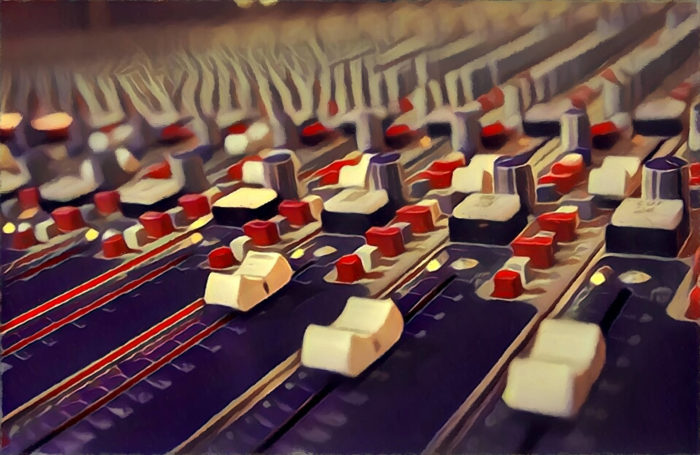Why is it that the live mix and the album mix end up being done differently?
Please Remember:
The opinions expressed are mine only. These opinions do not necessarily reflect anybody else’s opinions. I do not own, operate, manage, or represent any band, venue, or company that I talk about, unless explicitly noted.

 Want to use this image for something else? Great! Click it for the link to a high-res or resolution-independent version.
Want to use this image for something else? Great! Click it for the link to a high-res or resolution-independent version.Jason Knoell runs H2Audio in Utah, and he recently sent me a question that essentially boils down to this: If you have a band with some recordings, you can play those recordings over the same PA in the same room as the upcoming show. Why is it that the live mix of that band, in that room, with that PA might not come together in the same way as the recording? The recording that you just played over the rig? Why would you NOT end up having the same relationship between the drums and guitars, or the guitars and the vocals, or [insert another sonic relationship here].
This is one of those questions where trying to address every tiny little detail isn’t practical. I will, however, try to get into the major factors I can readily identify. Please note that I’m ignoring room acoustics, as those are a common factor between a recording and a live performance being played into the same space.
Magnitude
It’s very likely that the recording you just pumped out over FOH (Front Of House) had a very large amount of separation between the various sources. Sure, the band might have recorded the songs in such a way as to all be together in one room, but even then, the “bleed” factor is very likely to be much smaller than what you get in a live environment. For instance, a band that’s in a single-room recording environment can be set up with gobos (go-betweens) screening the amps and drums. The players can also be physically arranged so that any particular mic has everything else approaching the element from off-axis.
They also probably recorded using headphones for monitors, and overdubbed the “keeper” vocals. They may also have gone for extreme separation and overdubbed EVERYTHING after putting down some basics.
Contrast this with a typical stage, where we’re blasting away with wedge loudspeakers, we have no gobos to speak of, and all the backline is pointed at the sensitive angles of the vocal mics. Effectively, everything is getting into everything else. Even if we oversimplify and look only at the relative magnitudes between sounds, it’s possible to recognize that there’s a much smaller degree of source-to-source distinctiveness. The band’s signals have been smashed together, and even if we “get on the gas” with the vocals, we might also be effectively pushing up part of the drumkit, or the guitars.
Time
Along with magnitude, we also have a time problem. With as much bleed as is likely in play, the oh-so-critical transients that help create vocal and musical intelligibility are very, very smeared. We might have a piece of backline, or a vocal, “arriving” at the listener several times over in quick succession. The recording, on the other hand, has far more sharply defined “timing information.” This can very likely lead to a requirement that vocals and lead parts be mixed rather hotter live than they would be otherwise. That is, I’m convinced that a “conservation of factors” situation exists: If we lose separation cues that come from timing, the only way to make up the deficit is through volume separation.
A factor that can make the timing problems even worse is those wedge monitors we’re using, combined with the PA handling reproduction out front. Not only are all the different sources getting into each other at different times, sources being run at high gain are arriving at their own mics several times significantly (until the loop decay becomes large enough to render the arrivals inaudible). This further “blurs” the timing information we’re working with.
Processing Limits
Because live audio happens in a loop that is partially closed, we can be rather more constrained in what we can do to a signal. For instance, it may be that the optimal choice for vocal separation would simply be a +3 dB, one-octave wide filter at 1 kHz. Unfortunately, that may also be the portion of the loop’s bandwidth that is on the verge of spiraling out of control like a jet with a meth-addicted Pomeranian at the controls. So, again, we can’t get exactly the same mix with the same factors. We might have to actually cut 1 kHz and just give the rest of the signal a big push.
Also, the acoustical contribution of the band limits the effectiveness of our processing. On the recording, a certain amount of compression on the snare might be very effective; All we hear is the playback with that exact dynamics solution applied. With everything live in the room, however, we hear two things: The reproduction with compression, and the original, acoustic sound without any compression at all. In every situation where the in-room sound is a significant factor, what we’re really doing is parallel compression/ EQ/ gating/ etc. Even our mutes are parallel – the band doesn’t simply drop into silence if we close all the channels.
Try as we might, live-sound humans can rarely exert the same amount of control over audio reproduction that a studio engineer has. In general, we are far more at the mercy of our environment. It’s very often impractical for us to simply duplicate the album mix and receive the same result (only louder).
But that’s just part of the fun, if you think about it.